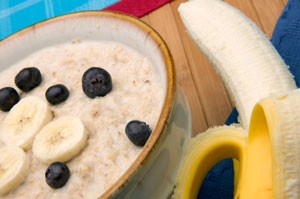Wake Up to the Health Benefits of Oatmeal
 Oatmeal may not seem like an exciting food. But if you learn how oatmeal can improve your health–and even make managing your diabetes a little easier–you may just change your mind.
Oatmeal may not seem like an exciting food. But if you learn how oatmeal can improve your health–and even make managing your diabetes a little easier–you may just change your mind.
What Is Oatmeal?
Oatmeal is made from oats, which are a type of grain called groats. When oats are harvested, they go through a milling process that removes the outer, inedible layer called the hull. After milling, the oats are steamed, heated, and then cooled. At this point, the oats are rolled, cut, or ground into flakes, oatmeal, or flour.
What’s The Best Type Of Oatmeal To Eat?
Choose steel cut or rolled oats whenever you can. Yes, they take longer to cook, but they’re the least processed type of oatmeal. Steel cut or rolled oats have a lower glycemic index, which means they are less likely to cause blood glucose spikes. The instant variety, on the other hand, is highly processed, and often full of sugar.
What Are The Benefits Of Eating Oatmeal?
Eating a bowl of oatmeal is a great way to start your day. One cup of cooked oatmeal has 165 calories, 30 grams of carbohydrate, 4 grams of fiber, and 6 grams of protein. Oatmeal is a highly nutritious cereal and can boost your health in the following ways:
- Lower cholesterol. Oats are a whole-grain food, which is a big benefit. But oats also have a type of soluble fiber called beta glucan that can help lower cholesterol levels.
- Improved blood glucose. Oatmeal’s soluble fiber slows digestion, which can prevent quick rises in blood glucose.
- Weight control. Starting off your day with a bowl of oatmeal can keep you feeling full for longer, thanks to its fiber content. This can help you eat less throughout the day.
- Better digestion. The insoluble fiber in oatmeal can help ensure regular bowel movements and less constipation. In addition, regularly eating oatmeal and other whole grain foods can prevent diverticulosis, a painful condition in which pouches form inside the large intestine.
- Lower cancer risk. Studies have shown that eating oatmeal may lower the risk of colon and breast cancer, thanks to both its fiber and antioxidant content.
How to eat oatmeal
There are plenty of ways to enjoy a hot bowl of oatmeal in the morning. Here’s how:
- Prepare your oatmeal with milk or a non-dairy substitute, or even apple cider.
- Add fruit like fresh or frozen berries, sliced banana, chopped apple, or any kind of dried fruit.
- Stir in a spoonful of jam or preserves.
- Give your oatmeal a protein boost by mixing in an egg while you’re cooking it.
- Add some healthy fats in the form of nuts and seeds (try chia, ground flaxseed, or hemp seeds).
- Spice it up with cinnamon, nutmeg, ginger, or cardamom.
- For a touch of sweetness, drizzle on a bit of honey or maple syrup (a small amount won’t add too many carbs).
- If time is an issue, cook your oatmeal overnight in a slow cooker, or try no-cook oatmeal: Mix one cup of oatmeal with 2 cups of low-fat milk (or almond or coconut milk), and place in the refrigerator overnight. Wake up to softened oats that are ready to eat.
Oatmeal isn’t just for breakfast, either. Try it for a healthy, pick-me-up snack. Or, mix oats into your meatloaf or meatballs. Oats can be used in baking, too.

